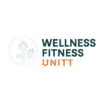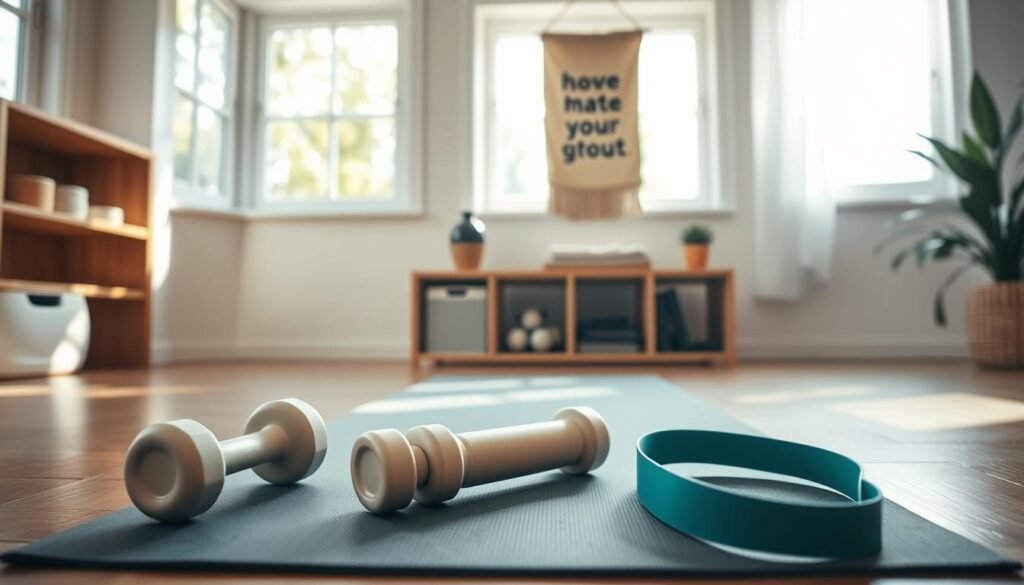Staying active doesn’t need gym memberships or expensive gear. Over 60% of Americans now choose to work out at home, CDC data shows. This is because home workouts save time, are flexible, and fit your personal needs.
Ever thought, “Can a living room really replace a fitness center?”? Hinge Health research found home exercises cut joint pain by up to 38% with regular practice. Even short, 20-minute sessions can increase energy and better your posture, especially when you’re busy.
New to exercise? Begin with simple moves like squats and planks. They build strength without needing any equipment. Clear a spot in your bedroom, watch free YouTube tutorials, and use apps like Nike Training Club to track your progress. Remember, it’s about being consistent, not perfect.
Key Takeaways
- Home workouts save time and money compared to gym memberships
- Short daily sessions yield measurable health improvements
- Medical studies prove effectiveness for pain management
- Minimal space and equipment needed for beginner routines
- Free digital tools simplify progress tracking
Understanding the Benefits of Home Fitness
Starting your fitness journey at home is more than avoiding gym crowds. It’s a lifestyle change with many benefits. For beginners, these advantages lay a strong foundation for success. Let’s see how home workouts can change your routine in a good way.
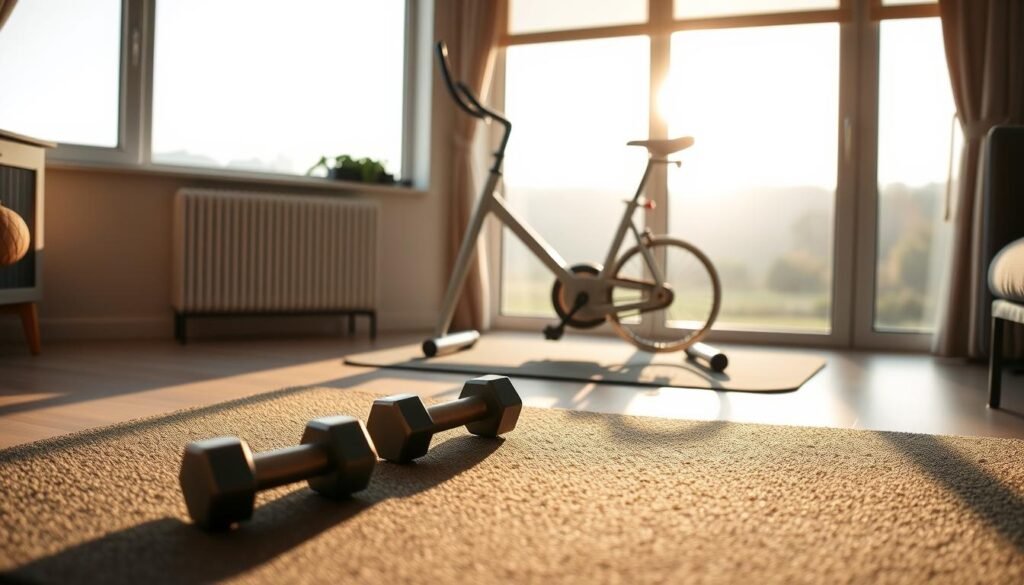
Cost-Effective Solutions
Gym memberships cost Americans an average of $58/month, the Bureau of Labor Statistics says. At home, you can save money:
- No enrollment fees or contract traps
- Reuse household items (chairs for step-ups, water bottles as weights)
- Free online tutorials vs. $75+/session personal training
Invest in 1-2 versatile items like resistance bands ($15-$30) instead of bulky machines. Over a year, you could save $500+ while achieving similar results.
Flexibility and Convenience
Home fitness fits your schedule. Squat during laundry cycles, stretch while coffee brews, or do yoga after late shifts. You avoid:
- Commute time (average 27 minutes round-trip to gyms)
- Waiting for equipment
- Weather-related cancellations
A 2023 study found people who workout at home stick to routines 43% longer than gym-goers. Your living room becomes a 24/7 wellness studio.
Building a Habit
Psychologists say habits follow a loop: cue, routine, reward. At home, you control all three:
- Cue: Keep yoga mat visible
- Routine: 10-minute morning mobility flow
- Reward: Post-workout smoothie
Start small – three 15-minute sessions weekly. As confidence grows, so will your consistency. One user reported, “Doing planks during TV ads helped me finally stick to core workouts.”
Setting Realistic Fitness Goals
Starting a home workout plan begins with setting clear goals. Whether you’re starting fresh or improving your routine, being clear is key. We’ll show you how to set goals that keep you motivated without feeling too much.
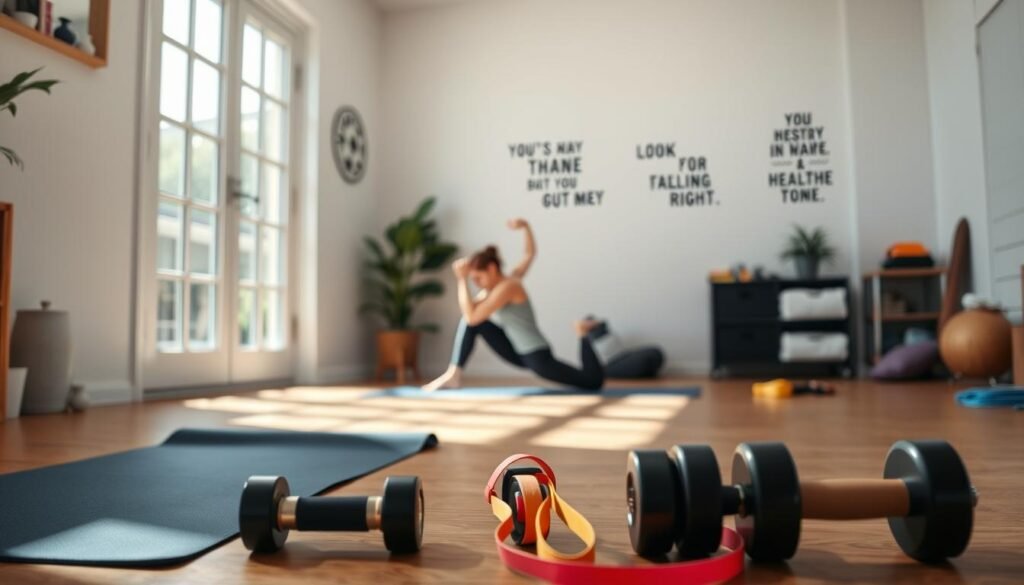
Short-term vs. Long-term Goals
Short-term goals are like stepping stones. They’re targets for 2–4 weeks, like doing three 20-minute yoga sessions a week. These small wins boost your confidence and momentum.
Long-term goals, like mastering 30 push-ups in six months, guide you but take time. Mix both to avoid feeling overwhelmed. For example, aim to lose 10 pounds in five months and also drink more water each week. This way, you celebrate small wins while working towards big goals.
SMART Goal Framework
The SMART method makes vague goals specific and achievable. Here’s how it works:
- Specific: “I’ll do a 15-minute morning bodyweight routine.”
- Measurable: Use a free app like Nike Training Club to track workouts.
- Achievable: Start with two days a week, not seven.
- Relevant: Make sure your goals match your priorities (like having more energy for work).
- Time-bound: “I’ll hold a 60-second plank by December 1st.”
Tracking Your Progress
Seeing your progress helps you stay consistent. A simple notebook works, but apps like FitOn offer reminders and streaks. Check your progress every Sunday to see if you’re on track.
Don’t just look at the scale. Notice if your posture improves or if you get winded less when climbing stairs. These small changes show your fitness plan is working, even if you don’t see it in the mirror yet.
Creating a Workout Space at Home
Starting a home exercise routine begins with making smart choices. Having a dedicated area helps you stick to your workout plan. We’ll show you how to make any space fit for fitness without spending a lot.
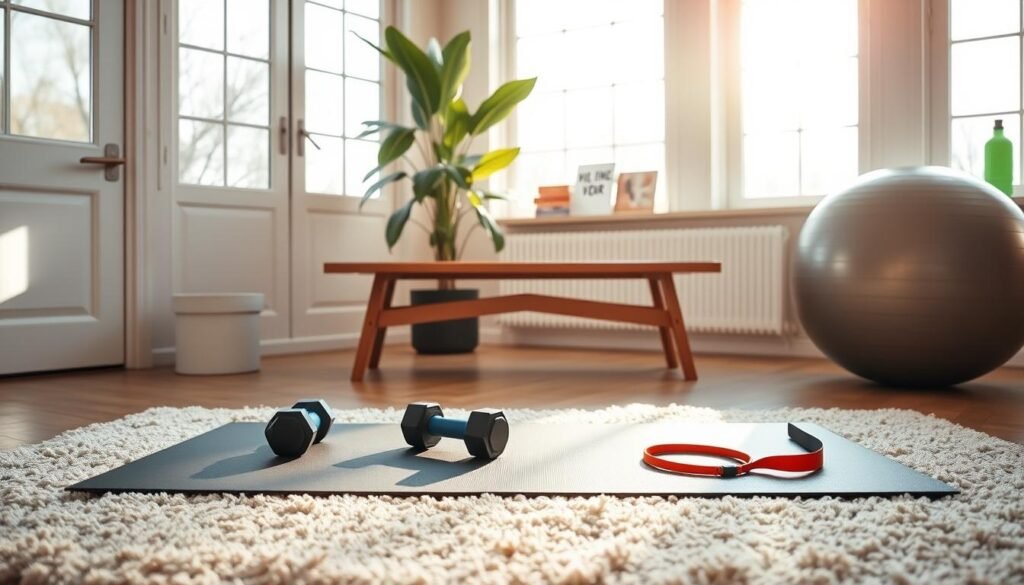
Choosing the Right Area
Find a spot that feels lively and free from distractions. A spare room is great, but even a corner in your living room or balcony can work. Make sure it has:
- Enough floor space for movements like lunges or yoga poses
- Good ventilation and natural light
- Proximity to power outlets for streaming workouts
Need space? Use under-desk cycling equipment. Every inch matters!
Equipment You Might Need
Don’t spend too much on fancy machines. Stick to versatile tools:
- Resistance bands (light/medium/heavy)
- Non-slip yoga mat
- Adjustable dumbbells
- Stability ball
These items cover most exercises and are easy to store. Add more as you grow.
Motivational Decor
Make your space motivating with:
- A vision board showing fitness goals
- Progress charts tracking reps or minutes
- Plants for air quality and positive vibes
Mirrors help with form, and music keeps you pumped. Personal touches make workouts enjoyable.
Types of Home Workouts to Consider
Starting your fitness journey at home means choosing workouts that match your goals, schedule, and space. Whether you’re short on equipment or prefer guided sessions, there’s an option for every lifestyle. Let’s explore three effective approaches to build strength, burn calories, and stay consistent.
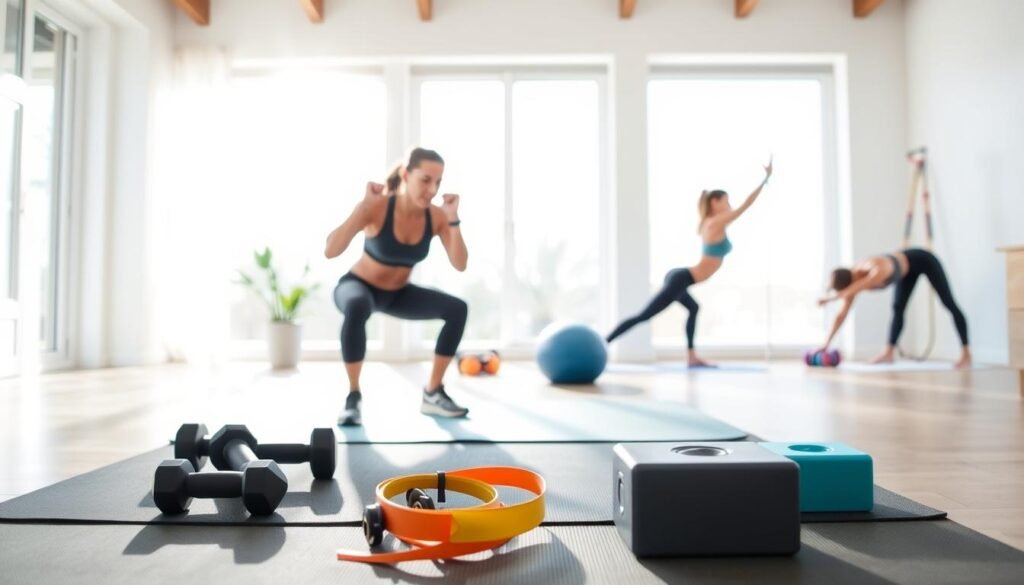
Bodyweight Exercises
No equipment? No problem. Bodyweight workouts use your own resistance to build muscle and improve mobility. Squats, push-ups, and planks are staples for targeting multiple muscle groups. For structured routines, check out this list of beginner-friendly bodyweight exercises.
These moves adapt easily to your fitness level. Increase reps or try advanced variations like pistol squats as you progress. Aim for 20–30 minute sessions three times weekly to see results.
Resistance Bands and Dumbbells
Add intensity to your routine with affordable tools like resistance bands or adjustable dumbbells. Bands create tension during movements like rows or glute bridges, while dumbbells enhance exercises like shoulder presses and lunges.
Pro tip: Start with lighter weights to perfect your form. Gradually increase resistance to avoid plateaus. A 15-pound dumbbell set and medium-strength bands cover most beginner needs.
Online Classes and Apps
Structured programs keep workouts fresh and motivating. Apps like Nike Training Club offer free plans ranging from HIIT to yoga. Streaming platforms like YouTube host thousands of guided sessions—search for “beginner workout routines at home” to find your fit.
Many apps track progress and adjust difficulty automatically. Try live virtual classes for real-time feedback. Schedule these sessions just like gym appointments to stay accountable.
| Workout Type | Time Commitment | Difficulty Level | Equipment Needed |
|---|---|---|---|
| Bodyweight | 20–40 minutes | Beginner to Intermediate | None |
| Resistance Bands | 25–45 minutes | Intermediate | Bands/Dumbbells |
| Online Classes | 15–60 minutes | All Levels | Phone/Tablet |
Establishing a Workout Routine
Creating a lasting home workout plan needs more than just wanting to. It requires smart planning and science-backed methods. Whether you’re an early bird or a night owl, exercising at your peak energy time boosts consistency. Let’s explore how to make a routine that lasts.
Finding Your Best Time to Exercise
Your chronotype—your natural wake-sleep cycle—is crucial for effective workouts. Early risers tend to do best in the 7-9 AM slot. Night owls might find their sweet spot in the 6-8 PM range. Research shows exercising when you’re most energetic can boost performance by up to 26%.
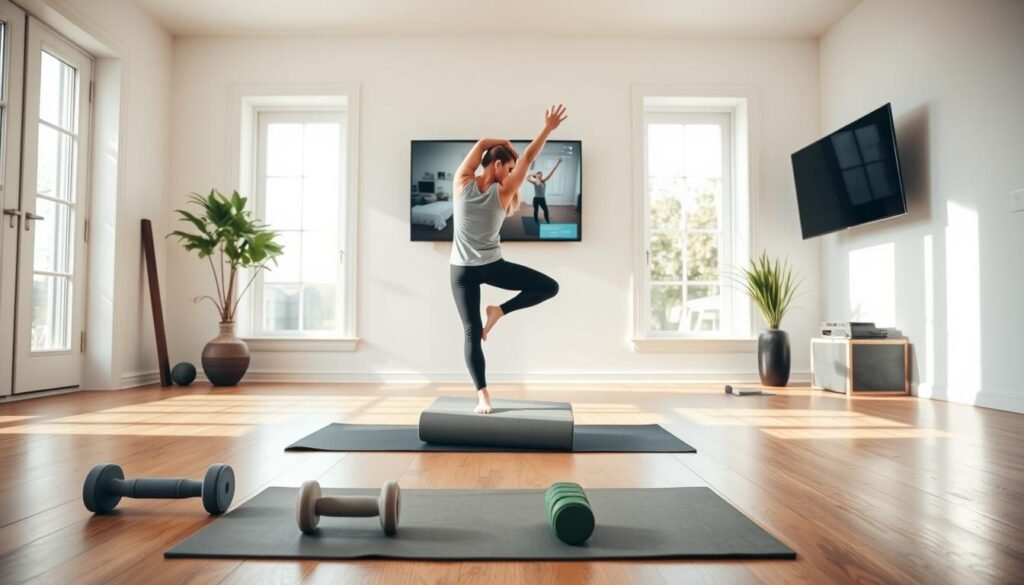
Scheduling Your Workouts
Follow the 80/20 rule: Spend 80% of your time on moderate workouts and 20% on high-intensity ones. This balance prevents burnout and builds stamina. Here’s a weekly plan to get you started:
| Day | Workout Type | Duration |
|---|---|---|
| Monday | Strength Training | 30 mins |
| Wednesday | HIIT | 20 mins |
| Friday | Yoga/Recovery | 40 mins |
Mixing Cardio and Strength Training
Switch between cardio (jump rope, dancing) and strength training (squats, push-ups) on different days. Circuit training, which combines both, is also effective. The Mayo Clinic suggests 150 minutes of cardio a week and two strength training sessions.
Warm-Up and Cool Down Techniques
Starting your workout without warming up is like driving in winter without warming the car. Proper warm-ups and cool-downs make your easy exercises to do at home safer and more effective. They prepare your muscles and help your body adjust to different activity levels.
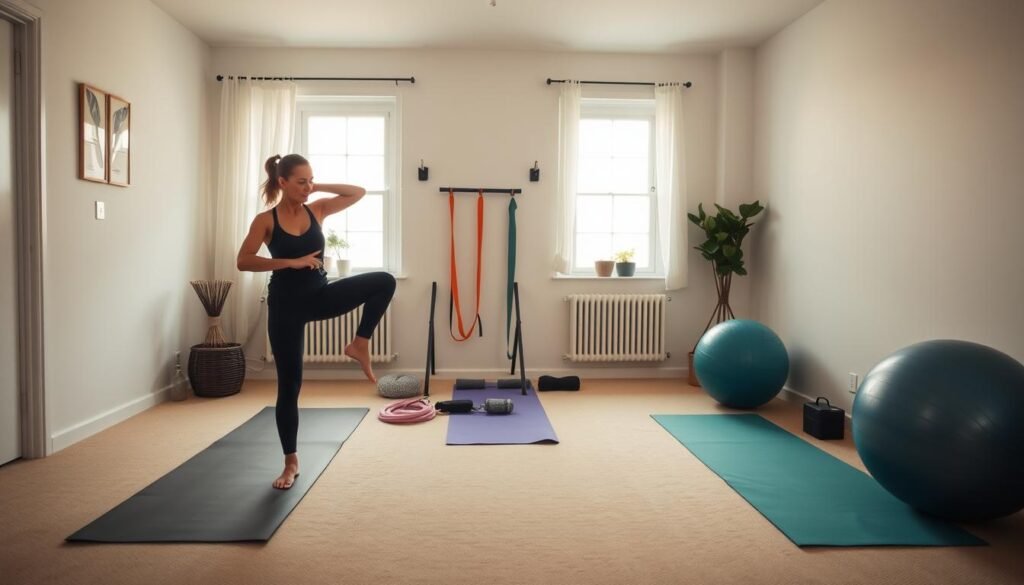
Why Warming Up Matters
A 5-10 minute warm-up boosts blood flow and lowers injury risks. Try dynamic movements like arm circles or bodyweight squats. These mimic your workout’s motions.
- Leg swings before lower-body workouts
- Shoulder rolls before upper-body routines
- Marching in place before cardio sessions
Hybrid workers can adapt these techniques using office chairs. Try seated torso twists to activate your core before lunch-break workouts.
Effective Cool Down Strategies
Gradually slowing your heart rate prevents dizziness and muscle stiffness. Focus on gentle movements for 3-5 minutes post-workout:
- Slow-paced walking in place
- Seated forward folds (use a chair if needed)
- Controlled breathing exercises
Pro tip: Pair your cool-down with hydration. It helps flush lactic acid from muscles.
Flexibility-Boosting Stretches
Incorporate these easy exercises to do at home to improve range of motion:
| Stretch Type | Duration | Best For |
|---|---|---|
| Cat-Cow Flow | 2 minutes | Spinal mobility |
| Standing Quad Pull | 30 sec/side | Leg flexibility |
| Doorway Chest Stretch | 1 minute | Upper body tension |
Those with limited mobility can modify stretches using towels or resistance bands. Consistency is key – even 10 minutes daily makes a difference.
Staying Motivated While Exercising at Home
Staying motivated with beginner-friendly home workouts is more than just wanting to do it. It’s about creating habits. We’ll look at ways to keep the excitement up, connect with others, and celebrate your achievements without leaving your home.
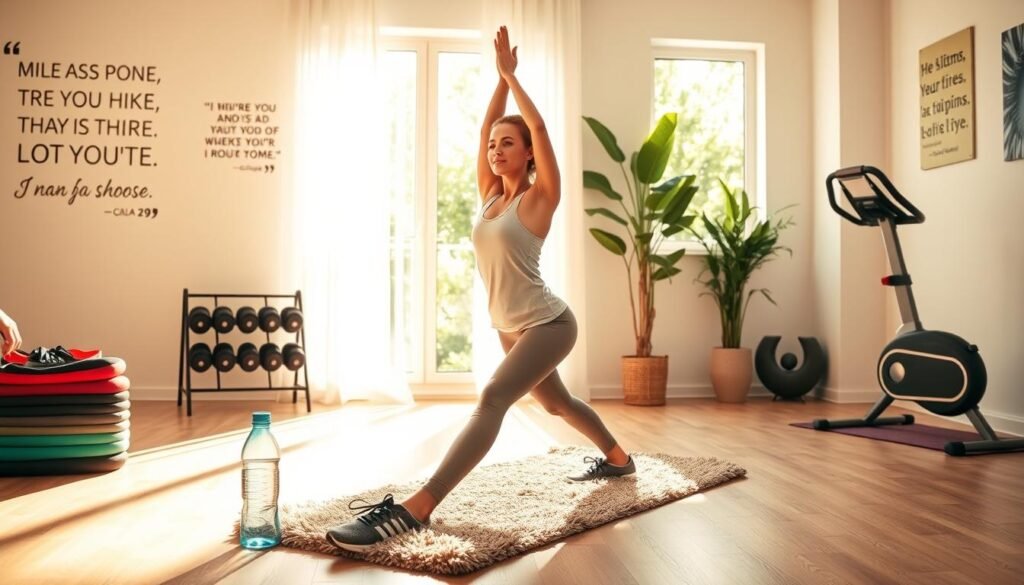
Setting Up Accountability
Adding accountability to your fitness goals makes it harder to skip workouts. Here are some strategies:
- Workout pacts: Make a deal with a friend to check in every day.
- Gamified apps: Apps like Habitica turn workouts into quests to defeat monsters.
- Public commitments: Share your goals on Strava clubs or Instagram to get support.
| Accountability Method | Best For | Platform Example |
|---|---|---|
| Workout Buddies | Social learners | Zoom/FaceTime |
| Gamification | Goal-oriented users | Habitica |
| Fitness Challenges | Competitive types | Strava Clubs |
Online Communities and Support Groups
Virtual fitness groups offer the support of gym buddies without leaving home. Reddit’s r/HomeFitness and Facebook’s “Beginner Home Workouts” group have:
- Daily check-in threads
- Form correction videos
- Live-streamed group workouts
Apps like Peloton and Nike Training Club offer expert guidance and community features. They have leaderboards and badges to make solo workouts feel like team efforts.
Rewarding Yourself
Celebrate your progress with these rewards:
- Fitness milestones: Get new workout clothes after 30 days
- Skill achievements: Treat yourself to a massage for mastering a new skill
- Consistency rewards: Enjoy a movie night after reaching weekly targets
“Rewards should motivate you, not undo your hard work. Choose rewards that support your health goals.”
Nutrition Tips for Your Fitness Journey
What you eat fuels your progress just as much as your workouts. Exercise builds strength and endurance. But, proper nutrition is the foundation for achieving your fitness goals. Let’s explore how to create sustainable eating habits that complement your home workouts.

Balanced Diet Essentials
A balanced diet isn’t about strict rules—it’s about giving your body the nutrients it needs. Focus on these three pillars:
- Proteins: Build and repair muscles (aim for 20-30g per meal)
- Complex carbs: Provide lasting energy (think oats, sweet potatoes)
- Healthy fats: Support hormone health (avocados, nuts)
Forget the “clean eating” myth. As registered dietitian Dr. Sarah Wilson says:
“Food isn’t moral. What matters is consistency, not perfection.”
Use this simple macro guide based on common fitness goals:
| Goal | Protein | Carbs | Fats |
|---|---|---|---|
| Weight Loss | 40% | 30% | 30% |
| Muscle Gain | 30% | 50% | 20% |
| Maintenance | 25% | 45% | 30% |
Meal Prep for Success
Planning meals saves time and prevents unhealthy choices. Try these budget-friendly strategies:
- Cook proteins in bulk (chicken, lentils)
- Use frozen vegetables for nutrients and savings
- Portion snacks into reusable containers
Here’s a sample 3-day meal prep template:
| Day | Breakfast | Lunch | Dinner |
|---|---|---|---|
| 1 | Oatmeal + berries | Grilled chicken salad | Salmon + quinoa |
| 2 | Greek yogurt + nuts | Turkey wrap | Stir-fried veggies + tofu |
| 3 | Egg scramble | Chickpea bowl | Lean beef + broccoli |
Hydration Importance
Water affects energy levels and recovery more than you might think. Try these simple hydration boosters:
- Start your day with lemon water
- Set hourly phone reminders
- Use a marked water bottle
For flavor without sugar, try these infused water combinations:
- Cucumber + mint
- Orange + basil
- Strawberry + lime
Dealing with Common Challenges
Starting a home fitness routine can be tough. You might struggle with time or distractions. Let’s find ways to stay on track.
Time Management Tips
It’s hard to fit workouts into your busy day. Block specific times for exercise in your calendar. This way, you treat them as important meetings.
Morning workouts are great. They help you avoid distractions and start your day full of energy.
| Challenge | Solution | Tools |
|---|---|---|
| Irregular schedule | 15-minute micro-workouts | Interval timer apps |
| Work overload | Priority-based planning | Todoist or Trello |
| Missed sessions | Accountability partners | Fitness buddy apps |
Overcoming Distractions
Make a distraction-free zone for workouts. Use app blockers like Freedom or FocusMe to block social media. This way, you can focus on your exercise.
Tell your family you’re busy during workout times. Use simple scripts like:
- “I’ll be unavailable from 7:00-7:30 AM for my workout”
- “Can we chat after I finish this exercise session?”
Staying Disciplined
Use visual progress trackers to stay consistent. A simple wall calendar with workout checkmarks shows your progress. Reward yourself after reaching milestones, like new workout gear or a massage.
On hard days, start with just two minutes of exercise. Often, this small start leads to a full workout once you get going.
Using Technology to Enhance Your Workouts
Your smartphone and laptop can be great tools for fitness. They help you track workouts, connect with trainers, and join communities. This keeps you motivated. But, it’s important to stay safe online while using these resources.
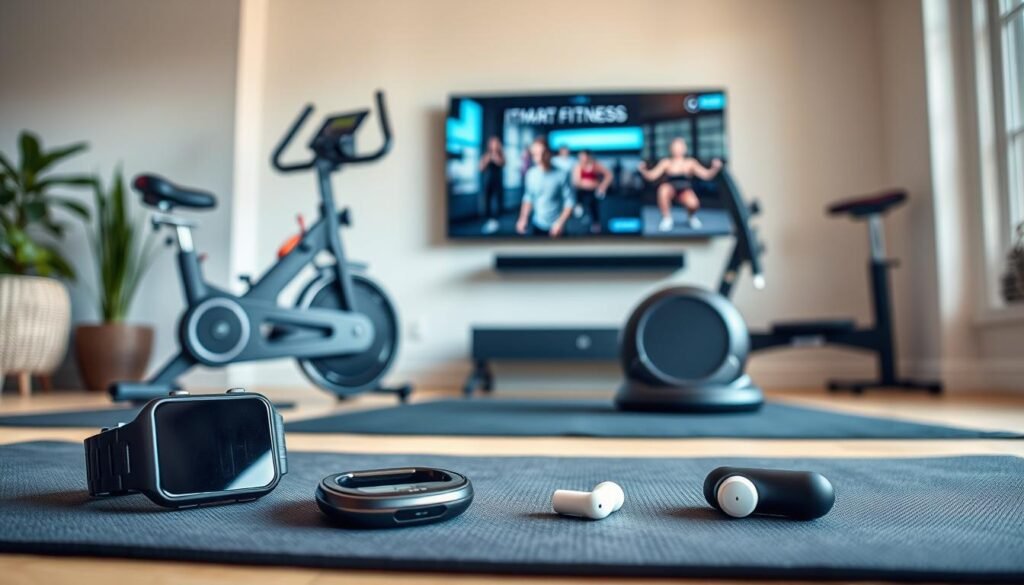
Fitness Apps to Track Your Progress
Apps like MyFitnessPal and Nike Training Club act as personal coaches. They log your exercises, count calories, and adjust plans based on your progress. Look for these features:
- Data encryption for health information
- Integration with wearable devices
- Customizable goal-setting options
Free apps may have ads, while paid versions ($9.99-$14.99/month) offer ad-free experiences and more analytics. Always check app permissions before downloading.
Virtual Classes and Personal Trainers
Platforms like Peloton and Zoom have changed home workouts. When choosing an online trainer:
- Verify certifications through ACE or NASM databases
- Request trial sessions before committing
- Check client reviews on third-party sites
Many gyms offer hybrid memberships for both in-person and virtual sessions. This flexibility helps when you can’t leave home.
Online Resources and Communities
Facebook groups and Reddit forums offer support, but safety is key. Follow these rules:
| Platform | Best For | Safety Check |
|---|---|---|
| Instagram Fitness Challenges | Visual inspiration | Avoid sharing personal metrics |
| Reddit r/Fitness | Expert Q&A | Verify moderator credentials |
| Discord Workout Groups | Real-time accountability | Use server privacy settings |
Never share credit card details in unsecured forums. Legitimate communities focus on sharing knowledge, not selling products.
Celebrating Your Fitness Journey
Every step in your fitness journey is worth celebrating. Whether it’s mastering a new yoga pose or running your first 5K, acknowledging your progress boosts motivation. Studies show that celebrating small wins helps build confidence and reinforces positive habits.
Recognizing Achievements
Use tools like Strava or MyFitnessPal to track your progress. Reward yourself with non-food items, such as new workout gear or a day off. Research from the International Journal of Behavioral Nutrition shows that intrinsic rewards lead to lasting commitment.
Setting New Challenges
Use the SMART-ER framework to set new goals. This means making goals Specific, Measurable, Achievable, Relevant, Time-bound, Evaluated, and Revised. For example, aim to shave 30 seconds off your mile time or add two weekly strength sessions.
Break down big goals into smaller phases. For instance, go from a 5K to a 10K run in six months. This approach helps you stay focused and motivated.
Sharing Your Progress with Others
Join local running clubs or online fitness groups for support. Share your achievements, but focus on your personal growth, not comparisons. Posting a sweaty selfie or joining a virtual challenge can inspire others and keep you on track.
Your fitness journey is always changing. Keep refining your routines, setting new goals, and connecting with supporters. Remember, progress may not always be linear, but consistency leads to lasting results.
FAQ
How much money can I save by working out at home instead of joining a gym?
Gym memberships cost /month on average. Home equipment like dumbbells is under 0. This means you can save over 0 a year by avoiding gym fees and commute costs.
Can home workouts really reduce chronic pain as effectively as gym sessions?
Yes! A 2023 Hinge Health study showed 74% of participants felt less pain. They used bodyweight exercises and stretching at home. Always talk to a doctor before starting new exercises, especially if you have health issues.
What’s the fastest way to build an exercise habit at home?
Use habit-loop psychology to link workouts with daily routines. Start with 5-minute sessions using apps like Habitica for tracking. Aim for 3 workouts a week to build consistency.
How do I create a workout space in a small apartment?
Use wall-mounted racks for resistance bands or foldable yoga mats. A sturdy coffee table can be used for step-ups. Even a small area near natural light can be great for Pilates or HIIT.
Which free apps are best for beginner-friendly home workouts?
Nike Training Club has 200+ free routines. Yoga With Adriene’s YouTube has 30-day challenges. FitOn offers 10-minute dumbbell circuits. Always check trainer certifications in paid programs.
How can night owls stick to morning workouts?
Adjust your schedule to fit your chronotype. Night owls do better in the afternoon. Use 5-minute warm-ups and caffeine 30 minutes before to help.
What’s the safest warm-up for limited mobility?
Chair-based exercises are good for limited mobility. Try seated arm circles and leg extensions. Use heat therapy and apps like SilverSneakers GO for senior-friendly routines.
How do I stay motivated without gym buddies?
Join Strava clubs or Apple Fitness+ challenges for virtual support. Make a workout pact with friends. Track progress in MyFitnessPal journals.
Are meal delivery kits worth it for home fitness nutrition?
Compare costs: DIY meal prep is cheaper than meal delivery kits. Use budget templates from Budget Bytes for balanced meals. Try partial kits for busy days.
How do I stop family interruptions during home workouts?
Use signs and app blockers to set boundaries. Negotiate schedules with roommates using Google Calendar. Noise-canceling headphones signal “do not disturb” times.
What red flags indicate fitness app scams?
Be wary of apps asking for unnecessary permissions. Check trainer certifications. Legit programs disclose cancellation policies upfront—never pay with gift cards or crypto.
How should I share progress without triggering social media comparison?
Share process-oriented posts instead of body metrics. Use private groups like Facebook’s “Home Workout Heroes.” Add content warnings on transformation photos and focus on mental health benefits.
